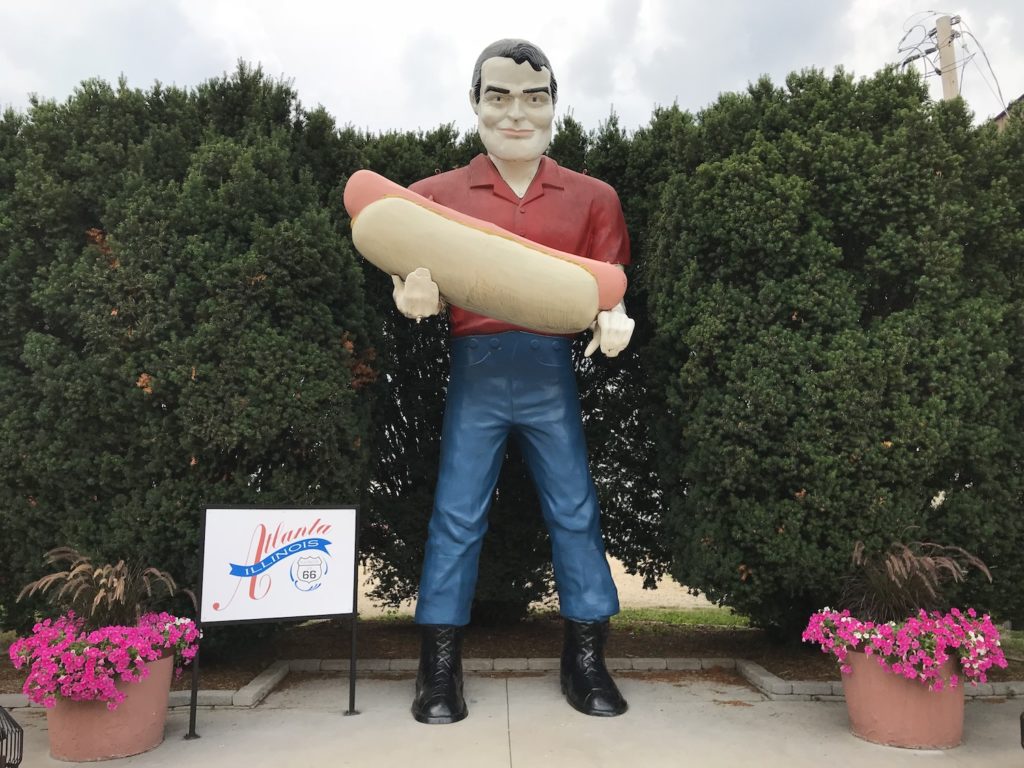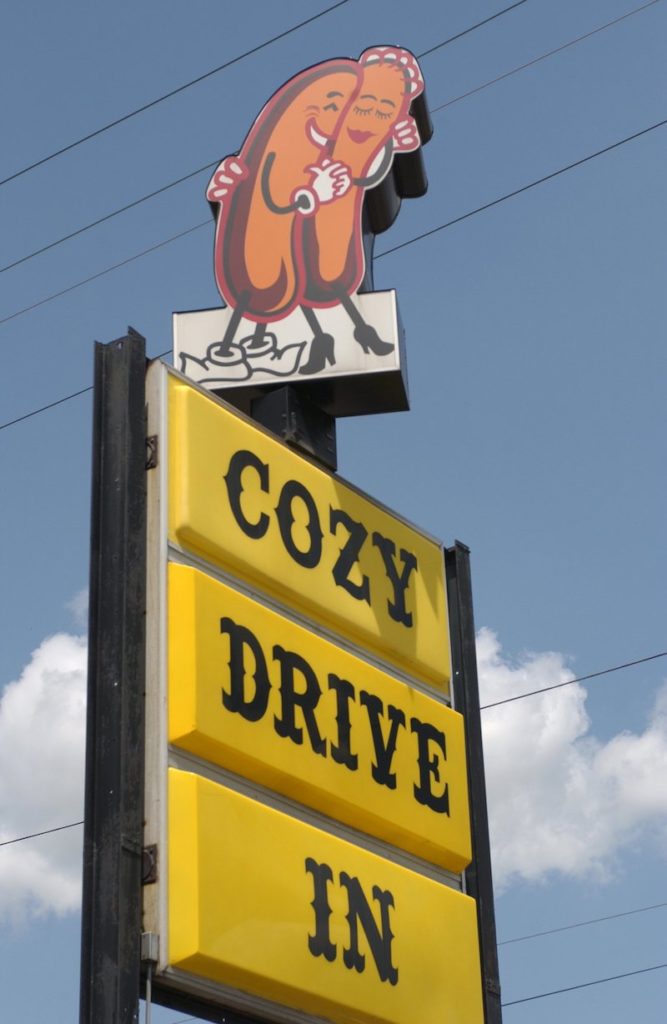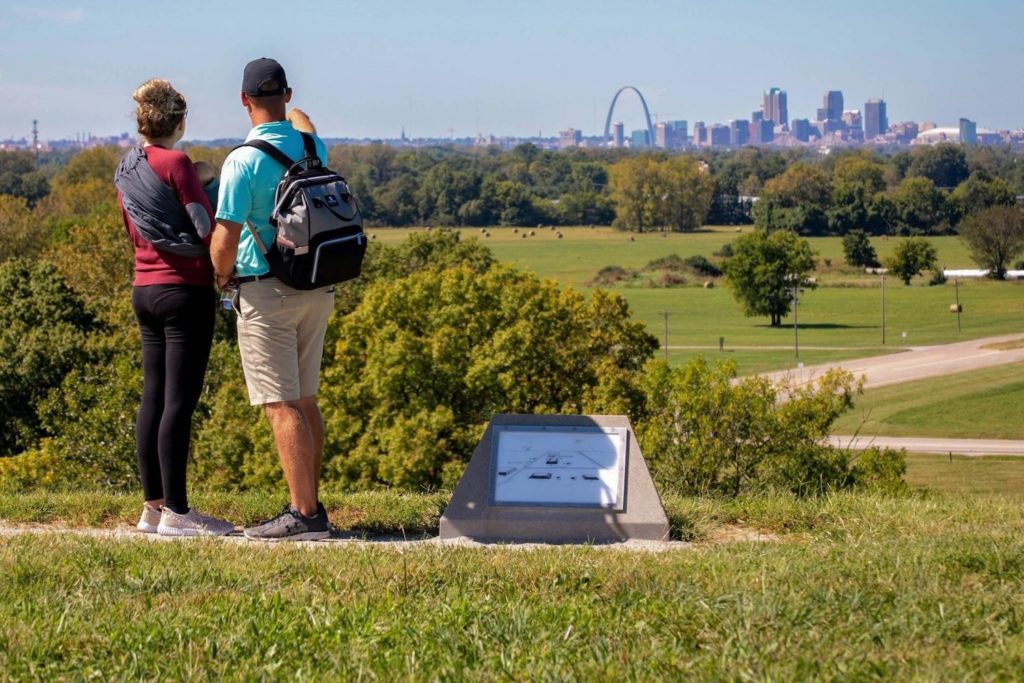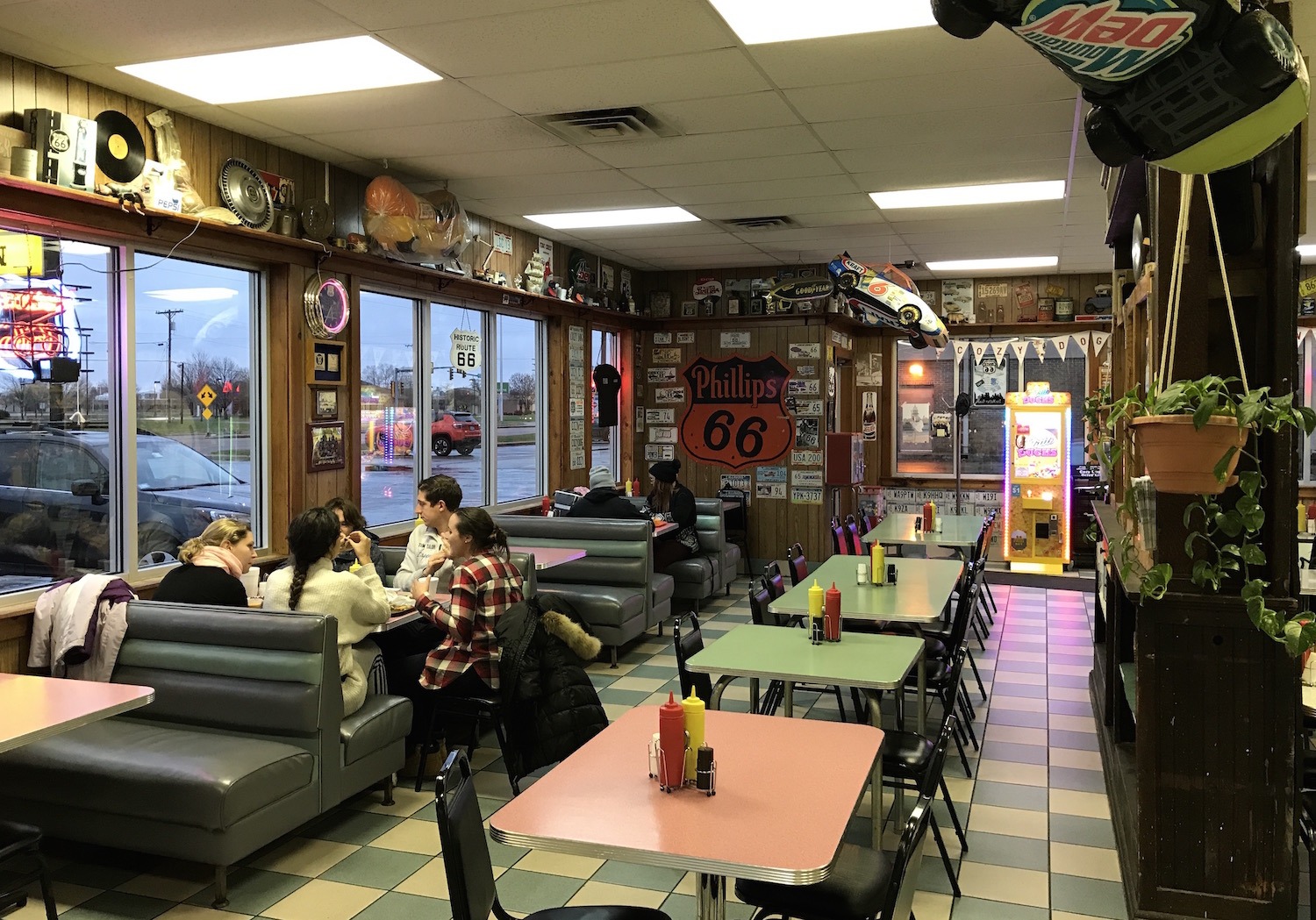U.S. Route 66 begins in Chicago, at the corner of Michigan Avenue and Jackson Street, but it’s never been a glamorous thoroughfare here. It runs southwest through the city along Ogden Avenue, before passing through the suburbs of Cicero, Berwyn, and McCook. Not until it crosses Interstate 80 does Route 66 really start living up to its reputation as, in the words of the book Weird Illinois, “a treasure trove of memories and a link to the days of two-lane highways, cool convertibles, and cozy little diners advertising homemade cakes and pies…[conjuring] up images of souvenir shops, tourist traps, tiny motor courts, flickering neon signs, drive-in theaters and cheesy roadside attractions.”
Although Route 66 was officially decommissioned in 1985, mostly replaced on its 301-mile run through Illinois by Interstate 55, the old highway is still well-marked throughout the state — and still celebrated in small towns that once lay along its route, but have been bypassed by the modern freeway. These are some of our favorite attractions on the drive from here to St. Louis.
Pontiac Daily Leader mosaics, Pontiac
On the outer walls of the local newspaper office are a series of mosaics, circa 1970, depicting the development of communications throughout the ages: first, cave painting, then Egyptians writing on papyrus, monastic scribes, and — finally — Gutenberg with his printing press. Pontiac also has the Illinois Route 66 Hall of Fame and Museum, with classic cars and roadside memorabilia, but it’s not quite offbeat enough to feature on this list.

“Paul Bunyon,” Atlanta
Turn off the highway onto the business strip of this population-1,600 hamlet and you’ll see a giant fiberglass Muffler Man holding the world’s largest hot dog. He’s not a native of Downstate, but of Cicero, where for 36 years he stood in front of Bunyon’s hot dog stand (misspelled to avoid trademark infringement) on that suburb’s stretch of 66. Bunyon’s closed in 2002, but the statue was such a part of the highway’s lore that it was moved 150 miles down the road to provide Atlanta with a reason for drivers to stop their cars. (Another Route 66 Muffler Man, the “Gemini Giant,” stands outside the Launching Pad Drive-in in Wilmington wearing a space helmet and holding a rocket.)
Lincoln Heritage Museum, Lincoln
Today, hundreds of Illinois landmarks are named after Abraham Lincoln. The city of Lincoln, though, was named for Lincoln before he was Lincoln, when in 1853 he was a one-term congressman and railroad lawyer who helped lay out the town. Lincoln College followed in 1865, making it the only school named for Lincoln during his lifetime. The Lincoln Heritage Museum, on the college’s campus, has a copy of the Lincoln bust sculpted by Thomas D. Jones, which was created during sittings in Jones’s room at Springfield’s St. Nicholas Hotel when Lincoln was president-elect. While Jones worked in clay, Lincoln read mail, welcoming the respite from office seekers. Jones fussed over his creation until August 1861, long after Lincoln had left for Washington. Lincoln biographer Harold Holzer called the bust “a true artistic triumph,” and it found a place in the Red Room of Lincoln’s White House. The museum doesn’t always display the bust, but visitors can view it in a storage room if they ask.

Cozy Dog Drive In, Springfield
In a double dose of Americana, this Route 66 diner bills itself as the “Birthplace of the Corn Dog.” According to the restaurant’s handwritten history, Cozy Dog founder Ed Waldmire first tasted the meal “at a roadside cafe in Muskogee, Oklahoma,” while driving from Springfield to his army air base in Texas. Ed ordered “a row of 3 wieners laid down in a hot iron, covered with a batter, & closed up to cook.” Back home in Springfield after his discharge, he invented “a rack that would clamp a flat stick. The impaled weiner could then be dipped & coated in batter, then the rack (ultimately designed to clamp 3 ‘dogs’) set into a fryer — with the dogs submerged just up to the base of the stick.” The kitsch factor is intensified by the restaurant’s sign, a hot dog couple dancing cheek to cheek.
Macoupin County Courthouse, Carlinville
Illinois has some baroque courthouses, but Macoupin County’s beats them all. According to the WPA Guide to Illinois, it was nicknamed “The White Elephant,” since it was expected to cost $50,000 when construction began in 1867, but came in a bit over budget at $1,380,500. “At the time the courthouse was built, no public building in the Middle West compared with it architecturally,” the Guide noted. “The limestone building consists of two rectangles, which cross at the center and are surmounted by a dome…Every door in the building is of iron: each of the elaborate outer doors weighs more than a ton.” The columns of the second-floor banisters are a pair of pelicans, with roses at their feet. Visitors can donate to the courthouse’s upkeep at a box just inside the front door. “They’re never going to tear this building down,” a sheriff’s deputy predicted. “It’ll have to fall down first.” A five-ton rock beside the Carlinville United Methodist Church commemorates a speech Lincoln delivered on August 31, 1858, during his Senate campaign against Stephen Douglas.
Mother Jones’s grave, Mount Olive
Mary Harris “Mother” Jones may be best known today as the namesake of a muckraking magazine. During her lifetime, which lasted from 1837 to 1930, she was known as “the most dangerous woman in America.” After losing her husband and four children to a yellow fever epidemic in Memphis 1867, Jones moved to Chicago to open a dress shop, but lost that in the 1871 fire. From then on, she devoted herself to labor activism, organizing miners’ strikes in West Virginia, the Upper Peninsula of Michigan, and Colorado. Jones died in Maryland, but is buried in Mount Olive’s Union Miners’ Cemetery, alongside eight of “my boys” — miners killed when they attacked a strikebreakers’ train in Virden. Her grave, in front of a memorial to the dead miners, is adorned with pro-labor pins left by admirers.

Cahokia Mounds, Cahokia
This is the oldest roadside attraction in Illinois — older than Route 66, older than cars, older even than paved roads. Cahokia rose to prominence on the banks of the Mississippi River in the 11th Century. At its peak, it may have contained as many as 20,000 residents, making it larger than London at the time, and the largest city in North America until 1780, when it was surpassed by Philadelphia. Unique to North America, Cahokia featured many of the accouterments found in the civilizations of Mesoamerica, or the Old World. It had a stratified society, with a hereditary chief at the top. It had well-organized villages, constructed around public plazas. The inhabitants played a ceremonial game known as “chunkey,” which involved hurling poles at rolling discs. Most significantly, the Cahokians constructed giant earthen mounds, which remain to this day on the site of their ancient city. The tallest, the 100-foot-high Monks Mound, was the seat of the chieftain. Archaeologists excavating the mounds have found the remains of victims sacrificed in the Cahokians’ religious rituals, a practice similar to the Aztecs and the Mayans. From the top of Monks Mound, a traveler can see clear across the Mississippi River to St. Louis.



